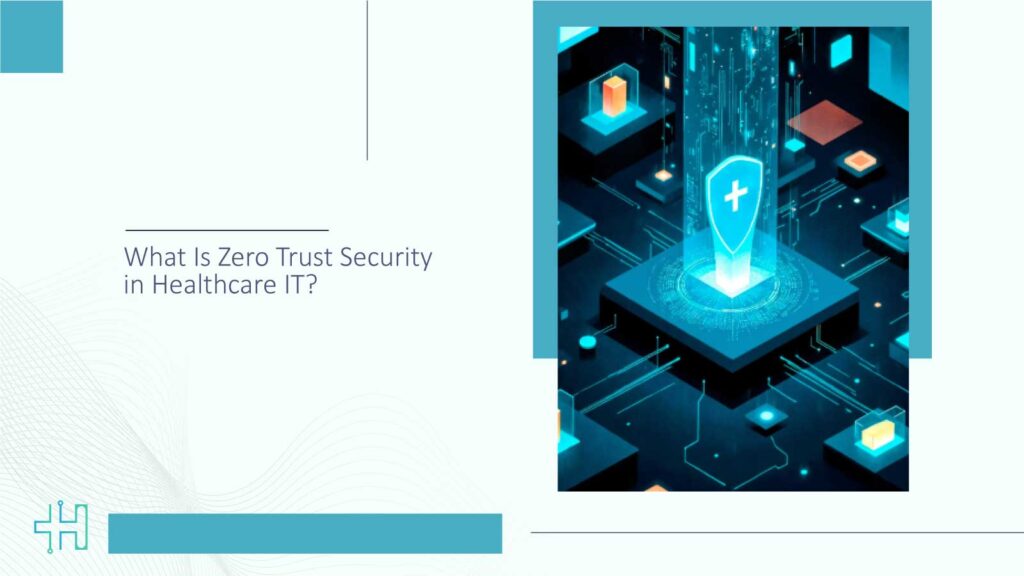In the rapidly evolving healthcare environment, the adoption of digital technologies has revolutionized patient care, streamlined processes, and enhanced access to better healthcare. However, this revolution of the digital world also generated stupendous cybersecurity issues.
Legacy security architectures, where internal networks are secure by default, are quickly failing to protect against sophisticated cyberattacks. This is particularly relevant in the healthcare industry, as patient information is a prime target for cyber attacks due to its high value on the black market.
Zero Trust Security appears to be an effective solution to all these issues. It is based on the “never trust, always verify” concept and insists that any access request, both inside the network and outside the network, is authenticated, authorized, and monitored regularly. This approach protects against a trust ever being issued and then reduces the risk of unauthorized access and potential data loss.
The Imperative for Healthcare
The increasing reliance of the healthcare sector on digital networks has spread its attack surface, and it is now a likely target for cyber attacks. Current reports indicate that cyber attacks on healthcare organizations have grown, with cases of ransomware, data breaches, and system intrusions becoming a common phenomenon. In June 2025, the healthcare sector experienced 66 reported data breaches, affecting over 7.1 million individuals, highlighting the critical need for robust cybersecurity measures. Not only do these attacks manage to violate patient confidentiality, but they also threaten life-critical health care services, leading to likely loss of life.
In addition, the Internet of Medical Things (IoMT) device and cloud Electronic Health Records (EHR) growth have brought new threats. Many devices and systems were not written from the ground up with robust security protocols and, therefore, are open to exploitation.
Zero Trust Security does this by constantly verifying that all applications, users, and devices are not only authenticated but also constantly monitored, thus securing the health infrastructure better from threats.
Core Principles of Zero Trust in Healthcare
Least Privilege Access: Individuals and devices receive the lowest privilege level possible to execute work. This limits the harm that can be caused by a compromised account as well as protects sensitive data from being accessed by unauthorized parties.
- Micro-Segmentation: The network is divided into isolated, smaller segments to compartmentalize potential breaches and restrict the lateral movement of threats. It assists in containing the effect of any security breach, providing early detection and mitigation.
- Continuous Monitoring and Analytics: Ongoing monitoring at the user level and within the system helps in identifying anomalies and potential security incidents at an early stage. Sophisticated analytics can recognize patterns typical of malicious activity and enable proactive action.
- Multi-Factor Authentication (MFA): Requests for various authentication types guarantee access as strictly available only for legitimate users. Incorporating an added level of security in the form of MFA reduces this even further for the intruder.
- Automated Threat Response: With the help of AI and machine learning, real-time discovery and removal of threats are made possible without human intervention. Automated response can readily minimize detection-to-remediation time, hence constraining potential damage.
Benefits of Implementing Zero Trust
- Enhanced Data Security: With frequent checking of access requests, Zero Trust minimizes the likelihood of unauthorized data leaks. In healthcare, above all, this is critical because patient data privacy is of paramount concern.
- Regulatory Compliance: Zero Trust implementations are HIPAA and HITECH-compliant in such a way that organizations maintain strict data protection standards. Compliance with these regulations not only keeps organizations outside the jurisdiction of legal proceedings but also builds patients’ confidence.
- Operational Efficiency: Automated security solutions remove the drag on IT staff and streamline security functions. This allows healthcare organizations to free up more resources to allocate to core patient care processes.
- Cost Savings: It can save healthcare organizations millions of dollars in potential fines, attorneys’ fees, and reputational harm. The cost of a breach is generally much greater than the cost of investment in a robust Zero Trust architecture.
Adoption Challenges
Despite the advantages of Zero Trust Security, there are some challenges for healthcare organizations in adopting it:
- Legacy Systems: Most healthcare organizations are running legacy systems, which may or may not be compatible with current security solutions. It can be expensive and time-consuming to upgrade such systems.
- Limitations of Resources: Limited budgets and personnel could be a stumbling block in rolling out large Zero Trust programs. Small healthcare centers, especially, might not have the resources to commit to the endeavor.
- Resistance to Change: Medical staff accustomed to having common workflows might be resistant to embracing new security measures. Training and change management should be provided to enable easy uptake.
Resolution of the problems requires a step-by-step approach, starting in high-risk environments and applying the Zero Trust framework progressively across the enterprise. Involving stakeholders early on and providing proper training may simplify the transition.
Rolling Out Zero Trust in Healthcare
As the cyber threats continue to mature, the adoption of Zero Trust by healthcare organizations will also grow. Continued innovation in AI-based security products and development in micro-segmentation technologies will continue to enhance the abilities of Zero Trust models. Healthcare organizations embracing change will enjoy greater chances to protect patient data, along with being able to reap trust in their services.
The increasing sophistication of healthcare IT infrastructure and emerging cyber threats emphasize the need for a robust security architecture. Zero Trust Security is an innovative and dynamic approach to securing critical healthcare assets. Zero Trust Security repeatedly authenticates every request to access and tries not to make assumptions about trust, thus lessening the exposure of healthcare organizations to cyber threats.
FAQs
1. What is Zero Trust Security in healthcare?
Zero Trust Security is a security model that assumes no user, device, or application can be trusted even within the network. Access should be authenticated continuously, authorized, and validated to protect sensitive healthcare data such as Electronic Health Records (EHRs) and medical devices.
2. What makes Zero Trust Security essential to healthcare organizations?
Healthcare organizations are the prime target for cyberattacks, as patient information is valuable. Zero Trust reduces the threat of data breach, ransomware, and insider attacks through tight access control and real-time monitoring of all devices and systems.
3. How does Zero Trust differ from legacy security architectures?
Legacy security designs assume inside network traffic by default and anticipate defense in the style of perimeters. Zero Trust does not assume any traffic as malicious and requires ongoing verification on all attempts at access, hence being far better suited to deal with today’s threats.
4. What are the key components of a healthcare Zero Trust model?
The core components are least-privilege access, multi-factor authentication (MFA), micro-segmentation, continuous monitoring and analytics, automated response to threats, and identity and access management (IAM) systems that are secure.
5. Is Zero Trust useful in regulatory compliance?
Yes. Zero Trust guarantees compliance with regulations like HIPAA and HITECH by having strict data access controls, tracking the activity of users, and maintaining security practices documented for protecting patient data.
Dive deeper into the future of healthcare.
Keep reading on Health Technology Insights.
To participate in our interviews, please write to our HealthTech Media Room at sudipto@intentamplify.com





